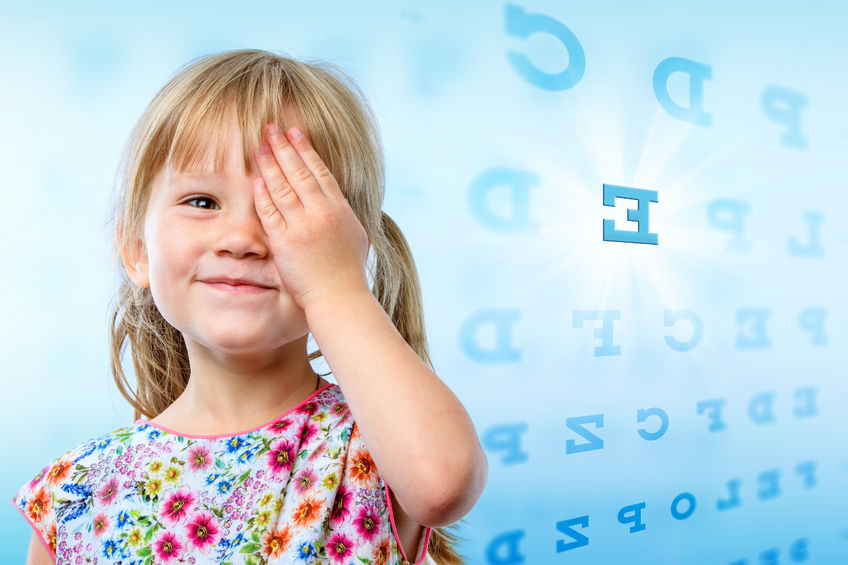Eye screening and tests

NHS eye screenings and tests for children
Eye tests for children
Routine eye checks are offered to newborn babies and young children to identify any problems early on.
Free NHS sight tests are also available at opticians for children under 16 and for young people under 19 in full-time education.
Why eye checks are important
The sooner any eye problem is found, the sooner you and your child will be able to get any treatment and support needed.
Children and their parents may not realise they have a vision problem so, without routine tests, there's a risk a problem may not be spotted. This may affect their development and education.
If you have any concerns about your child's vision please speak to your GP or go to your local opticians. The earlier a problem is picked up the better.
When will my child's eyes be checked?
A child’s eyes get checked at various stages during their early years:
Within 72 hours of birth - A babies eyes will be checked for any obvious physical problems as part of the newborn physical examination.
Between 6 and 8 weeks old - This is a follow-up physical examination to check for any obvious problems that were not picked up soon after birth, usually carried out at your GP surgery.
Around 1 year, or between 2 and 2-and-a-half years - As part of the child's health and development reviews, parents/guardians will be asked if they have any concerns about the child's eyesight. Eye tests can then be arranged
Between 4 or 5 years old
Vision screening is carried out during reception year at mainstream schools / academies, and, should also be offered to home schooled children. Independent schools are also required to provide vision screening during reception year.
The purpose of vision screening is to identify whether a child has reduced vision in one or both eyes.
Detailed information on Vision Screening for 4-5 year olds can be found here:
NHS Sight Tests
Free NHS sight tests are available at opticians for children under 16 and for young people under 19 in full-time education.
If you are worried about your child's eyes / vision or there is a history of glasses, squint or lazy eye in the family, do not wait for the vision screening at school. Please speak to your GP or go to your local opticians. The earlier a problem is picked up the better.
It is recommended that children should have an eye test every two years, as problems can occur at any age. Signs of a possible eye problem can include:
- Holding objects very close to their face
- Blinking a lot
- Problems reading – for example, they may need to hold books close to their face and they may lose their place regularly
- Problems with hand-eye co-ordination – for example, they may struggle to play ball games
- Being unusually clumsy
- Regularly rubbing their eyes
- Sitting too close to the TV
- The eyes not pointing in the same direction (a squint). One eye may turn inwards, outwards, upwards or downwards, while the other eye looks forward
- Older children complaining of headaches or eye strain
Even if none of the above are displayed, there could still be an underlying eye condition.
![]() Don't worry about the costs, as all NHS sight tests are free for children under the age of 16.
Don't worry about the costs, as all NHS sight tests are free for children under the age of 16.
For more information, read: entitlement and costs.
Generally, a sight test will consist of testing the vision of each eye, to determine how well it is “seeing” things, testing the movement of each eye, and having a look inside the eye to ensure it is healthy.
If the eye test detects any problems, your child will be referred to the Ophthalmic team which generally includes ophthalmologists, optometrists and orthoptists. For more information, read: What eye tests may be carried out.
![]() Children do not have to be able to read to have their eyes examined. It's possible to see whether the child has a squint or needs glasses without asking them any questions, using age-appropriate tests and equipment.
Children do not have to be able to read to have their eyes examined. It's possible to see whether the child has a squint or needs glasses without asking them any questions, using age-appropriate tests and equipment.
What are eyedrops used for during an eye test?
Some children, especially younger ones, might need eyedrops for their eye test. This is important because it can ensure that the correct glasser are given and that the optometrist or opthalmologist can have a clear look at the internal structure of the eye.
It is not unusual for the eye drops to sting a little after they are put in. Once put in, the drops will need a while before they work (the darker the eyes the longer it takes).
Eyedrops make the pupils larger so the back of the eye can be seen properly. They also relax the focusing mechanism in the eye so the prescription for glasses can be as accurate as possible.
Once the drops start working, your child might become sensitive to light. You could bring sunglasses or a brimmed hat or cap just in in case. Some children may also feel that their vision is blurred or fuzzy. Again, this is because the drops stop the focusing mechanism working. The effects of the eye drops usually wear off after 6 to 10 hours and are fully gone within 16 to 24 hours.
Click here, for further information on the following:
· Find NHS opticians
· Find visual impairment support services
· Childhood cataracts
· Long-sightedness
· Short-sightedness
· Why are eye tests important?



